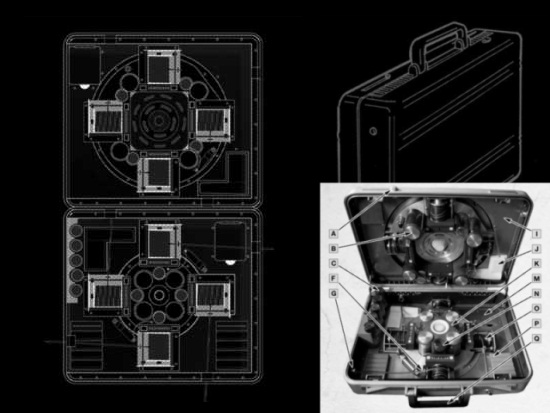The Dream-Sharing Technology of Inception
Will it be possible one day to share dreams?
Inception's emphasis on story over technology works, and is yet another example of director Christopher Nolan's mastery of unconventional story progression (see: Memento). But it's still worth taking a look at the technology that allows fictitious characters to experience—and influence—the dreams of others.

To promote the movie, Warner Brothers featured the dream machine the protagonists used to work their somnambulistic magic. The PASIV (Portable Automated Somnacin IntraVenous) device is a movie prop that drives Inception's story.
According to WB, the machine's "Lithium-iodide" batteries provides up to 200 hours of power. A "LED display with atomized timer" provides the operator with continuous system updates. Numerous IV lines allow multiple users to essentially network their respective dream states, with one person acting as a conduit for everyone to hallucinate around.
Truth be told, there isn't much to work with. WB went through the paces of creating a fictional manual governing the use of the PASIV device, which even lists the machine's primary components. Yet it falls short of actually specifying anything readers can use to speculate on its actual operation. How can a mere IV—mainly used to constantly pump fluids into the human body—allow people to exchange ideas through dreams? What kind of system shares the subconscious of many people, without any lasting damage, except under very special circumstances?
Still, a future that allows people to exercise some control over dreams with some training—and experience entire lifetimes in one sitting—sounds very exciting. The PASIV is a concept that can potentially inspire researchers and inventors to produce real-world technology that lives up to the fiction, literally opening up possibilities limited only by our imagination.
Sign up to get the BEST of Tom's Guide direct to your inbox.
Get instant access to breaking news, the hottest reviews, great deals and helpful tips.

Rico was a contributing writer at Tom's Guide. Based in the Philippines, Rico was plugged into the latest tech news to cover the latest future-gazing products and industry announcements. Rico no longer actively writes for Tom's Guide, and now works as a systems engineer. During his time at the site, he covered topics such as robotics, home office products and retro video games.
-
hythos Interesting, but behind the times. Though much smaller and no IV required, I should have patented it two years ago when I first came up with the idea :/Reply -
Wolygon "Still, a future that allows people to exercise some control over dreams"Reply
Lucid dreaming is a very real thing.
Don't thumbs down be, it is real. Just because you don't believe it is; doesn't mean it isn't. -
dtq the_punkinator"Still, a future that allows people to exercise some control over dreams"Lucid dreaming is a very real thing. Don't thumbs down be, it is real. Just because you don't believe it is; doesn't mean it isn't.Reply
I wasnt aware there was any controversy left over whether lucid dreaming existed, its laboratory proven, its well known amongst people who discuss their dreams.
Im sure many people have had some experience of becoming aware they are dreaming whilst dreaming, the first step to controlling their dreams. Its not a huge leap from there to exercising control.
OF course its one thing having the ability to control your dreams its another entirely to consistantly do so, I find even after 3 decades my dreams can still rebel against my orders at times :D. I also manage to wake myself up too often when exerting too much control over the dream.
The hypnagogic entry to the best of lucid dreams can be terrifying for the uninitiated. It was for me for many years before I had ever heard the term lucid dreaming.
As far as shared dreaming goes, Ive had several episodes of coinciding dreams with other people, and only one which I could call a shared dream, and that was witnessed by a third person...
A very late night in the early 90's staying at my half brothers house his mum came in to see what was going on as we were arguing, we were debating whos turn it was on a non existant hand held console that projected its display onto the wall in the room. We both have sleep issues, and we had both managed to enter a non rem atonia dream state and our console discussion on the edge of sleep turned into the shared perception of a projecting console. I guess the conversation between us in this state managed to reinforce and synchronise the major points of the dream. I could not say that everything he saw was what I saw their was no "magical telepathic link" but the overiding principle was the same and we were both seeing a hand held projecting console and discussing it out loud whilst asleep much to the bemusement of his mum. Only when she switched on the light did we actually wake up.
I have very disrupted sleep so I have alsorts of weird sleep \ wakefullness interactions, and so a high proportion of lucid dreams. The other side affects of my disrupted sleep are another topic entirely... -
zaznet the_punkinatorLucid dreaming is a very real thing.Reply
Lucid dreaming is not an outside force on your dream state. Control over yourself and the dream you are in is very different than an outside influence getting an intended effect while aware of your dream.
Movies have always shown future technology. They had flying cars long before they became common place on our streets... -
There is a lot to this that is for real and you can explore you can read the Lucid Dream FAQ http://web-us.com/lucid/luciddreamingfaq.htm and the Science of Binaural beats http://web-us.com/thescience.htmReply
